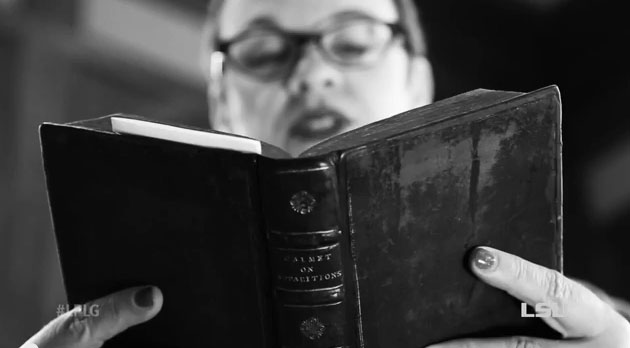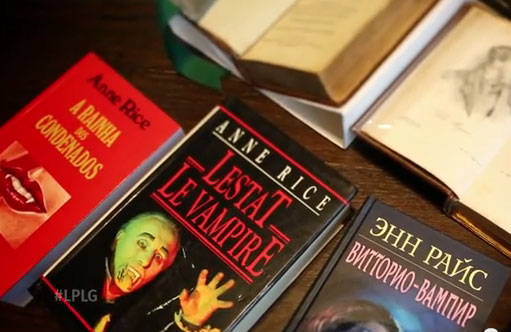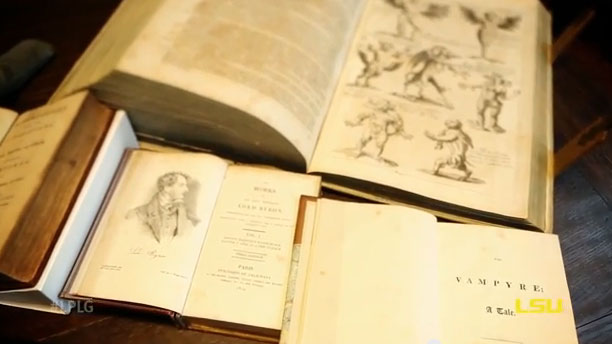Vampires at Hill!

LSU Libraries Special Collections is expanding upon and growing a new collecting area -- we are looking at the world of Vampires! This collection builds on vampire fiction by Louisiana authors or with a Louisiana setting already held in the Louisiana and Lower Mississippi Valley Collection (LLMVC), of which there are more than 100 titles, including DVDs (True Blood) and other works of fiction. Recent acquisitions include over 400 volumes of Anne Rice vampire fiction translated into numerous languages. Special Collections’ growing Vampire Collection also complements the library’s existing holdings of 18th and 19th-century Gothic fiction, tales of mystery and the macabre, science fiction and fantasy, early occult science, and “outsider” literature (i.e. the Codrescu collection). Academic fields of study that it would support include literature, history, folklore, psychology, religion, foreign languages, art history, graphic design, GLBT studies, film studies, and popular culture.
Vampire literature is a publishing phenomenon that has been growing since at least the 1720s. Originating in central Europe, it spread to England in the mid eighteenth century. The first major work on vampires published in English, in 1759, was a translation of the French Benedictine monk Augustin Calmet’s treatise on apparitions and vampires. The work proved popular and was retranslated in 1850, helping to cement the notion of vampires in the Western European consciousness. Special Collections holds both of these volumes.
The late eighteenth century saw the rise of Gothic fiction. In the early 1800s, Robert Southey, Samuel Taylor Coleridge, and Lord Byron were including vampires in their poetry. The first major work of vampire fiction in English was The Vampyre, a novella published in 1819 by Bryon’s personal physician, John William Polidori. Special Collections recently acquired a copy of the work.
Vampires appear in many works of Victorian fiction, culminating in Bram Stoker’s Dracula (1897). The genre was popular in France and Germany as well, important examples including Paul Féval’s Le Chevalier Ténèbre (1860), La Vampire (1865), and La Ville Vampire (1874); Marie Nizet’s Le Capitaine Vampire (1879); and Hans Wachenhusens Der Vampyr – Novelle aus Bulgarien (1878).
In the twentieth century, vampire literature crossed from traditional Gothic fiction into science fiction. As early as 1908, we find vampires in outer space in Gustave Le Rouge’s Le prisonnier de la planète Mars. Richard Matheson’s I Am Legend (1954) is set in a futuristic Los Angeles. Multi-volume vampire epics, of which more than 200 have been published in English alone, trace their origin to Marilyn Ross’s Barnabas Collins series, published from 1966 to 1971. Anne Rice’s 10-book Vampire Chronicles (1976-2003) has sold 80 million copies worldwide.
Scholars in a variety of disciplines use vampire literature to explore a myriad of themes, from feminism to post-colonialism. Gay vampire fiction is largely a recent development, but vampire fiction has always been charged with sexuality, and even Sheridan Le Fanu’s 1872 novella Carmilla featured a female vampire with lesbian inclinations. The genre has also crossed into juvenile literature, comic books, and graphic novels. Several magazines have been published, featuring interviews with actors, stories about vampire films, and news of book releases and vampire-related events. To see a bit more about the Vampire Collection at Hill Memorial Library, watch our new and exciting YouTube video. For questions about the collection, contact Michael Taylor, Assistant Curator of Books.


